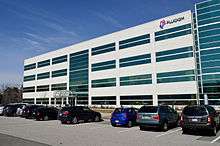Fluidigm
Formerly called | Mycometrix |
|---|---|
| Public (2011– ) | |
| Traded as | NASDAQ: FLDM |
| Founded | 1999 |
| Founders |
|
| Headquarters | South San Francisco, California, United States |
Key people | Gajus Worthington (President, CEO) |
Number of employees | 500 (2014) |
| Website | Official website |

Fluidigm Corporation is a public, American company engaged in the design, manufacture and sale of biological research equipment based on integrated fluidic circuit technology.[1] In 2009, Fluidigm was described as "the world's leading manufacturer of microfluidic devices."[2] Among the applications to which Fluidigm products are put to use are protein crystallization, genotyping, DNA analysis and PCR.[3]
Business model
Fluidigm's products leverage the capabilities of multilayer soft lithography to create microfluidic devices,[4] specifically technology developed by one of the co-founders and branded "Integrated Fluidic Circuitry".[5]
Fluidigm is a public company traded on the NASDAQ stock exchange under the ticker symbol FLDM.[6]
Fluidigm has a number of academic partners whose engagement is aimed to provide a wow factor to exemplar product uses; partners include Wellcome Trust Sanger Institute, the Broad Institute, the Genome Institute of Singapore and Kyoto University.[1]
Among companies which include "integrated microfluidic technology" into their products, the only competitor which a market focus on biotechnology as of 2011 appeared to be RainDance Technologies.[3]
Going into 2015, the company is making an effort to infuse industrial design, aesthetic and customer centricity principles to help distinguish their products from those of competitors and generate a distinctive brand experience for users.[1]
History
Fluidigm was founded in 1999 as "Mycometrix" by Steve Quake and Gajus Worthington.[6][5] The company was formed to commercialize technology developed by Quake at the California Institute of Technology referred to as microfluidic large-scale integration and "branded" under the name Integrated Fluidic Circuits.[5] As of 2015, Worthington remains with the company as president and chief executive officer (CEO),[1] while Quake was a member of the company's scientific advisory board as of 2011.[5]
The company completed a successful initial public offering (IPO) in February 2011, raising about US$75,000,000.[6][7] This followed a failed, ill-timed IPO in 2008.[6] As of the 2011 IPO, Fluidigm had not yet become profitable, but had accumulated nearly US$200,000,000 in debt.[6]
Operations
At the end of 2014, Fluidigm had a headcount of 500 personnel.[1]
In addition to its headquarters and laboratory facility in South San Francisco, California, which it expanded in 2014,[8] the company in 2005 established the first biochip manufacturing facility in Singapore.[2][5] The Singapore facility was in 2009 led by Grace Yow, who also held the position of Fluidigm vice president of worldwide manufacturing.[2]
Products
Fluidigm's products typically consist of single-use biochips, instrumentation for handling biochips and software for instrument operation and data collection and analysis.[2] No Fluidigm products had been approved for clinical use in the United States as of 2009.[2]
Fluidigm's first commercial product was aimed at the protein crystallization market and was launched in 2003 under the brand "Topaz".[5] The company's second marketed product targeted high-throughput DNA amplification and was launched in 2006 under the brand "BioMark".[5] By 2013, BioMark had been adapted to real-time PCR and was capable of running >9000 reactions in parallel.[9] A high-throughput genotyping system, FLUIDIGM EPI, was introduced in 2008.[5]
The C1 Single-Cell Auto Prep, or C1 system, was released in the early 2000s aimed at delivering 96 single-cell capture and processing events in parallel.[1] One aim of development forward from the C1 system is increasing parallel throughput.[1] This initial line of instruments purportedly cost about US$200,000 apiece to purchase in 2011.[6] One reported use for the instruments is "to identify signatures of induced pluripotent stem cells".[6]
Another product line was launched in late 2014 with an introductory instrument, an "imaging mass cytometer", on which subsequent products will be built.[1]
Notes
References
- Angelescu, Dan E. (2011). "5.3.1 Microfluidic Large-Scale Integration: Fludigm". Highly Integrated Microfluidics Design. Integrated Microsystems. Artech House. ISBN 9781596939806 – via Google Books. Note: the book version viewed did not include the entire chapter cited here, only pages 225, 226 and 227.
- Dutton, Gail (15 Jan 2015). "Fluidigm Pioneers Single-Cell Biology". Corporate Profile. Genetic Engineering & Biotechnology News. 34 (2). pp. 8–9.

- GenomeWeb staff reporter (19 Sep 2014). "PerkinElmer; Guardant Health; PacBio; BGI Tech; Thermo Fisher, UCSD; Fluidigm; Cynvenio; and More". In Brief This Week. GenomeWeb. New York, NY.

- Nanotechnology Business Journal editors (7 Sep 2009). "Fluidigm: 250 Million Microfluidic Valves Manufactured -- and Counting". Nanotechnology Business Journal. NewsRx, LLC – via HighBeam Research.
- Timmerman, Luke (11 Feb 2011). "Fluidigm Raises $75M in Second Chance at IPO". San Francicso. Xconomy.
- Tse, Andrea (10 Feb 2011). "Fluidigm Pops After IPO". The Street.
- Yan, Hong; Kun, Liu Xiao (13 Jun 2013). "5. Real-Time Fluorescent PCR by Labeled Primer with a Single Fluorescent Molecule". In Nolan, Tania; Bustin, Stephen A. PCR Technology: Current Innovations (3rd ed.). CRC Press. ISBN 9781439848050 – via Google Books.
External links
| Wikimedia Commons has media related to Fluidigm. |